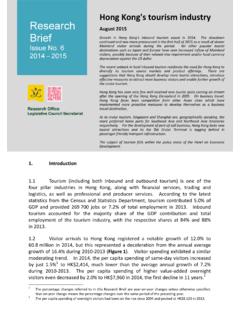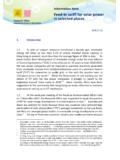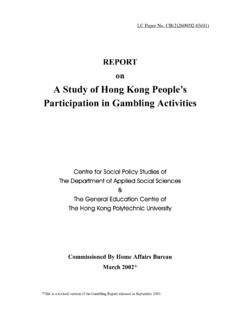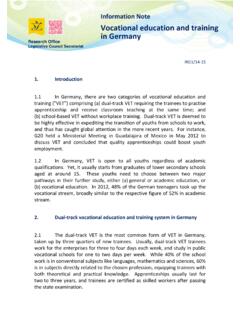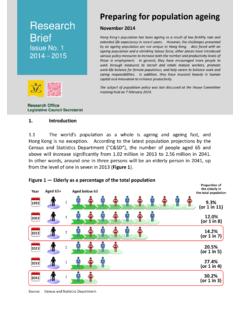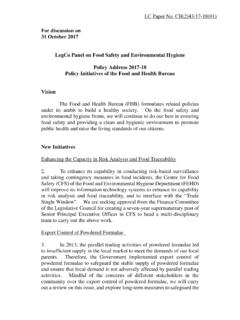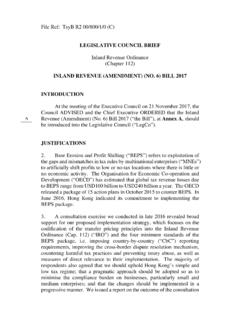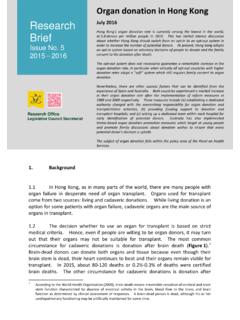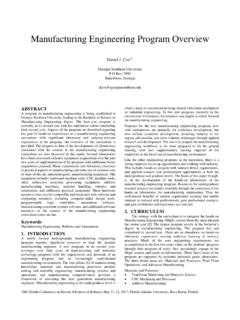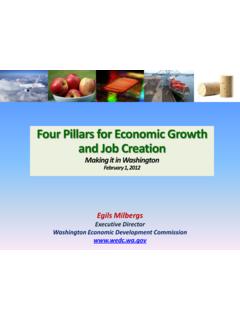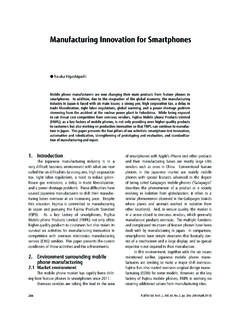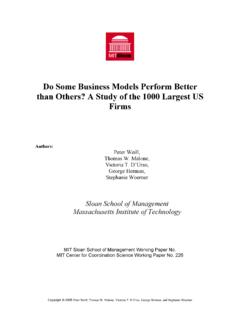Transcription of Four Pillars and Six Industries Research Hong Kong: Brief
1 Research Brief Issue No. 3 2014 2015 four Pillars and Six Industries in Hong Kong: review and outlook February 2015 The four pillar Industries have been a driving force of Hong Kong's economic growth for years. The Government has also identified and promoted Six Industries to help diversify the local industry structure. The trading and logistics services industry is the largest among the four Pillars in terms of both GDP contribution and employment. But its growth rate and job creation potentials lagged behind other Pillars during 2002 2012. The tourism industry, being the smallest pillar, outperformed other Pillars in the above two areas over the same period. Many jobs created in the tourism industry are low paid jobs requiring less skills and this is important in view of limited job opportunities for lower skilled workers. The cultural and creative Industries have been the key growth driver of the Six Industries in recent years. However, their development is relatively narrow based.
2 The other five Industries also have their own challenges that must be addressed in the years ahead. The subject of industry policy falls within the policy areas of the Panel on Economic Development and the Panel on Commerce and Industry. Research Office Legislative Council Secretariat Professional and producer services Financial services Trading and logistics Tourism 2002 200520072010 1. Introduction The four pillar Industries , comprising trading and logistics, financial services, professional and producer services, and tourism, have been a driving force of the Hong Kong economy for years. They had grown much faster than the overall economy during 2002 2007, resulting in an increase of their combined GDP contribution from in 2002 to a peak of in 2007 (Figure 1). The figure has since then eased to in 20121, reflecting the weakened growth momentum of some pillar Industries in recent years. Figure 1 GDP contribution of the four pillar Industries , 2002 2012 Source: Census and Statistics Department.
3 1 The 2012 figures are the latest figures available from the Census and Statistics Department ("C&SD"). 2 2. four pillar Industries The four pillar Industries were first identified by the then Financial Secretary in his 2002 2003 Budget Speech as the key economic sectors of particular importance since they could "foster the development of other sectors, give impetus to [the overall] economy, and create employment".2 After a decade of development, the trading and logistics services industry remained the largest pillar in 2012, but its growth rate3 was the lowest during 2002 2012 (Figure 2). The tourism industry, being the smallest pillar, outperformed the others to grow most rapidly over the period. Figure 2 GDP contribution and growth of the four pillar Industries Notes: (1) Growth rate for 2002 2012. (2) 2012 figure. Source: Census and Statistics Department. Trading and logistics Review Among the four pillar Industries , the trading and logistics services industry4 is the largest in terms of both GDP contribution and employment.
4 Yet the industry recorded the lowest growth, at 57%, between 2002 and 2012. It also lagged 2 See The 2002 03 Budget. 3 In this Research Brief , the growth rate of an industry is measured in terms of the rate of change in its GDP contribution in real terms. 4 Trading and logistics broadly comprise wholesale, import/export trade, freight transport and storage services, postal and courier services. Hong Kong's real GDP growth(1): 55% Professional and producer services Real growth(1) : 91% GDP contribution(2) Financial services Real growth(1) : 105% GDP contribution(2) : Trading and logistics Real growth(1) : 57% GDP contribution(2) Real growth(1) : 161% GDP contribution(2) : behind other pillar Industries in job creation with the number of people employed remaining virtually unchanged at around 764 900 over the period. The above development was partly due to slackening export performance in recent years, amidst the waning trade intermediation role of Hong Kong upon the continuing integration of Mainland with the global economy.
5 Another factor was the intense competition from the neighbouring ports in the Pearl River In 2013, Hong Kong could not hold on to its place as the world's third busiest container port and lost it to Shenzhen (Figure 3). Figure 3 Hong Kong's ranking among the world's busiest container ports Source: Census and Statistics Department. Outlook Looking ahead, competition from other South China ports will continue to weigh on the future growth of Hong Kong's port cargo throughput. According to a consultancy study commissioned by the Government6, total container throughput handled by Hong Kong is forecast to grow by a mere per year between 2015 and Air cargo, which has higher value added content than port cargo, should help provide added growth impetus to the trading and logistics services industry. However, air cargo handled by Hong Kong International Airport is forecast to grow by an average annual of during 2008 20308, lower than the corresponding figure of during 2002 2007.
6 5 Hong Kong acts as a gateway port for South China cargo. According to BMT Asia Pacific (2014), the Hong Kong port is not as competitive as other South China ports in terms of terminal handling charges and inland transport cost by road for South China cargo. In addition, there is diminishing distinction between the Hong Kong port and its competitors in terms of quality or capacity. 6 See BMT Asia Pacific (2014). 7 The low forecast figure reflects, among others, the setback in South China cargo handled by the Hong Kong port which is forecast to decline by an average annual of during 2015 2030. See BMT Asia Pacific (2014). 8 See Airport Authority Hong Kong (2011). 4thBusiestport1st 2nd 20133rd4th4 Financial services Review The higher paid financial services industry9 is the second largest pillar industry and grew by 105% between 2002 and 2012. Yet much of the increase was fuelled by the rapid growth in the earlier years with the industry's GDP contribution up by 126% in 2002 2007 (Figure 4).
7 The industry slowed down in the ensuing years to grow by 7% in 2008 2012. The distinct downtrend reflected the subdued global investment environment over the period, which had turned cautious after the outbreak of the global financial crisis in 2008 and the escalation of the euro debt crisis during 2010 2012. As a result, Hong Kong's stock market entered into a prolonged correction during 2008 2012, with the Hang Seng Index losing about 30% and the stock market turnover down by some 40% from their peaks in 2007. Figure 4 Growth of the financial services industry in real terms, 2002 2012 Source: Census and Statistics Department. Outlook There have been calls for Hong Kong to develop a broad array of asset classes and build more resilience for its financial services While Hong Kong possesses "first mover" advantages in offshore renminbi business, it is 9 Financial services comprise (a) banking services, (b) insurance services, and (c) other financial services including stock brokerage, asset management, financial leasing, and investment and holding companies, etc.
8 10 See Financial Services Development Council (2013). Hong Kong's real GDP growth:37% in 2002 2007 and 11% in 2008 2012 0000002008 2012: +7% 2002 2007:+126% HK$ million500,000400,000300,000200,000100,0 0002002 2003 2004200520062008200720092010201120125 lagging behind Singapore in foreign exchange transactions. In 2013, Singapore was ranked as the world's third largest foreign exchange market which was two places above Hong Kong. In addition, Hong Kong's debt market is relatively small compared to its banking and equity markets. In 2013, the outstanding amount of debt securities accounted for some 67% of GDP in Hong Kong, compared with 139% in the United Kingdom, 126% in the United States, 95% in South Korea and 68% in Professional and producer services Review The GDP contribution of the professional and producer services industry12 was on a generally uptrend between 2002 and 2012 and grew by 91% over the period. A large proportion of the professional and producer services supplied in Hong Kong has been closely linked to its role as a business hub in the region, particularly the Mainland.
9 Domestically, the strong revival in local construction activity after 2008 has fuelled the demand for architecture and engineering services, which have grown faster than the other segments of the industry in recent years (Figure 5). Figure 5 Growth of the professional and producer services industry in real terms by segment, 2002 2012 Source: Census and Statistics Department. 11 See Trade Development Council (2014) and International Organization of Securities Commissions (2014). 12 Professional services cover legal, accounting, auditing, architecture and engineering activities, management and management consultancy activities, information technology related services, advertising, specialized design and related services, etc. Producer services refer to services for use by other companies in the local economy, as well as exports of services to companies and individuals. Architecture and engineering activities+181%Legal, accounting and auditing services+68%Information technology and advertising +129%Other producerservices+75%6 All employees HK$ Travel agency and reservation service HK$ HotelHK$ tradeHK$ $ According to the Government13, the Mainland will continue to feature prominently in the Hong Kong economy, both as a source and as a destination of external direct investment.
10 This will in turn accentuate Hong Kong as an ideal platform for both Mainland companies to go global and large multinationals to expand their business in the Mainland. Domestically, construction works should remain hectic in the coming years. According to the latest forecast by the Construction Industry Council, overall construction expenditure in Hong Kong will stay at a high level of HK$180 HK$210 billion in 2017 2018, compared with HK$175 billion in 2012 Tourism Review The tourism industry, including both inbound and outbound tourism15, is the smallest pillar industry. It grew by 161% between 2002 and 2012, the fastest among the four pillar Industries . This was attributable largely to the buoyancy in inbound tourism following the launch and progressive extension of the Individual Visit Scheme ("IVS"). As a result, the number of people employed by the tourism industry increased by a total of 108 700 or 76% between 2002 and 2012. Many jobs in the tourism industry require relatively lower skills, and are thus paid less as reflected in the median hourly wages (Figure 6).
